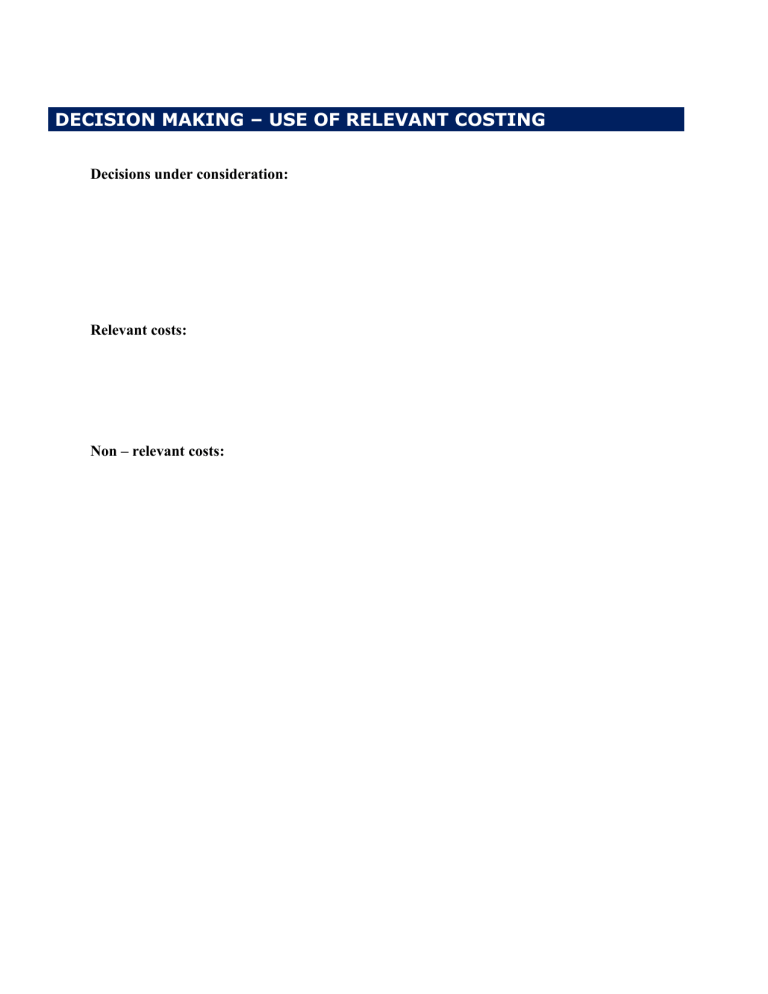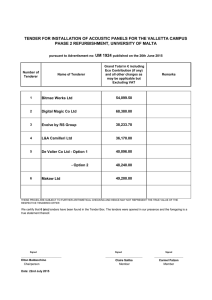
DECISION MAKING – USE OF RELEVANT COSTING
Decisions under consideration:
Relevant costs:
Non – relevant costs:
Make or buy decision
The decision to make a component or product ‘in-house’ or to buy from an outside supplier.
The underlying assumption of this decision is that all fixed costs of manufacture are general to the organisation as a whole and hence only the marginal cost of making the component is relevant.
Decision criteria : Compare marginal (variable) cost of making to the purchase price
(the marginal cost of buying).
Example 1 Clemence Ltd
Clemence Ltd produces a number of components, two of which it is considering buying in, components X and Y.
Cost of making (£)
Variable
Fixed
Total
Purchase price (from outside supplier)
X
14
4
18
17
Y
28
4
32
25
Required:
Should Clemence Ltd make or buy in?
Example 2 PCO Ltd
PCO Ltd is considering the alternatives of either purchasing a component from an outside supplier or producing the component itself. The estimated costs to the company of producing a component are as follows:
Direct labour
Direct materials
Variable overheads
Fixed overheads
100
300
50
200
650
The outside supplier has quoted a price of £400 for supplying the component.
Required:
Should PCO Ltd produce or buy the component from the supplier?
Example 3 Central Ltd
Central Ltd makes four components, W, X, Y and Z, for which costs in the coming year are expected to be as follows:
Production units
Unit marginal costs
Direct materials
Direct labour
Variable production overheads
W
1,000
£
4
8
2
14
X
2,000
£
5
9
3
17
Y
4,000
£
2
4
1
7
Z
3,000
£
4
6
2
12
Direct attributable fixed costs per annum and committed fixed costs are: incurred as a direct consequence of making W incurred as a direct consequence of making X incurred as a direct consequence of making Y incurred as a direct consequence of making Z other fixed costs (committed)
1,000
5,000
6,000
8,000
30,000
50,000
A sub-contractor has offered to supply units of W, X, Y and Z for £12, £21, £10, and
£14 respectively.
Required:
Should the company make or buy the component?
Other important factors to consider
1. If the components are sub-contracted, the company will have spare capacity. How should that spare capacity be profitably used, that is, are there hidden benefits to be obtained from sub-contracting?
2. Would the sub-contractor be reliable with supply and delivery time?
3. Would the sub-contractor supply the same or improved quality components as the one produced internally?
4. Does the company wish to be flexible and maintain better control over operations by making everything itself?
5. The going concern of the sub-contractor should also be considered.
Shutdown (discontinuance) decisions
The decision whether to shut down a part or segment of a business. The focus of the question is the impact of the shutdown on the cost base. Revenue will be foregone but which costs will be affected.
The avoidable costs include variable costs and specific fixed costs. Specific fixed costs are those costs specific to the part or segment of the business to be shutdown. General fixed costs will not be relevant.
The simplest way to consider such a problem is to re-draft any information in the form of a marginal costing profit statement.
Any product that produces a positive contribution is worth undertaking as it will contribute to profit, unless
● The company can use the capacity used by this product to produce another new product with a higher contribution than that of this first product.
● The capacity used by this product can be used to produce more of the other existing product with higher contribution.
Example 4 Jones Ltd
Jones Ltd operates three divisions within a larger company. The CEO has been shown the latest profit statements and is concerned that division C is losing money.
You are required to advise her whether or not to close down division C.
Division
Sales
Variable costs
Fixed costs
Profit/(loss)
A B C
(000s) (000s) (000s)
100
60
80
50
40
30
20
20
20
10
20
(10)
You are also informed that 40% of the fixed cost is product specific, the remainder being allocated arbitrarily to the divisions from head office.
Required:
Should division C be shut down?
Example 5 Fantum Ltd
Fantum Ltd has three operating divisions. The expected financial results of each division next year are as follows:
Sales
Variable costs
Specific fixed cost
Apportioned head office costs
Profit or loss
Division A Division B Division C
£
50,000
(30,000)
(12,000)
£
30,000
(18,000
(10,000)
£
40,000
(20,000)
(10,000)
(5,000)
3,000
(4000)
(2000)
(5000)
5000
Required:
Taking only the financial results next year into consideration, recommend whether or not division Y should be closed down.


